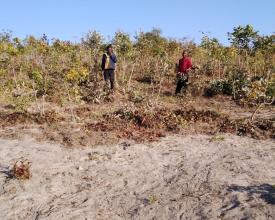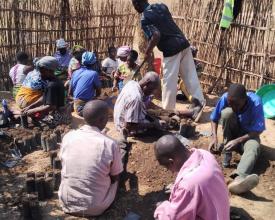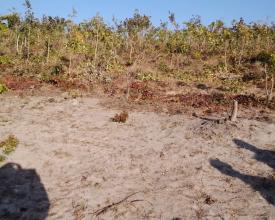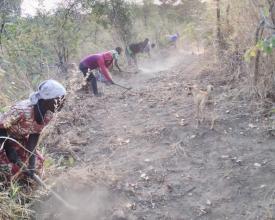
Landscape restoration and soil and water conservation
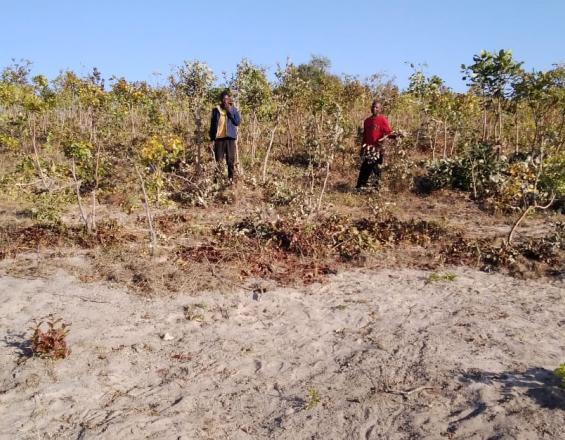
The Department of Forestry in Malawi is implementing National Forestry Landscape Restoration Strategy which addresses environmental issues including land degradation, deforestation and biodiversity loss. In support, Tetra Tech ARD through MCHF project mobilised communities in Traditional Authority Kambwiri in Salima District to undertake Landscape restoration activities to undo severe degradation due to wanton cutting down of trees, which resulted in unreliable and scarcity rains, continued droughts and extream weather conditions and poor farm production, hence, abstract poverty. Traditional Authority Kambwiri and his people have made a vow to restore back the lost glory through undertaking key forest restoration and management activities, good agricultural practices and soil and water conservation measures.
Over 1500 hectares of degraded Hills is now under Traditional protection since October 2021 and over 213 hectares is under firebreak.
Contexte
Défis à relever
Environmental degradation in form of deforestation, soil erosion and poor agricultural practices are the main issues being addressed. These problems contributed to biodiversity loss, unreliable and scarcity of rains, poor farm productivity whose outcome was socio-economic status of people in the area. Over 86% of the population in the area live below poverty line (NSO, 2019). Due to poor living standard of people, participation in development activities including natural resources management was problematic.
Emplacement
Traiter
Résumé du processus
Assisted natural regeneration, soil and water conservation technologies and farmer managed natural regeneration are interrelated. They both support and improve livelihoods of local communities through provision of wood fuel for domestic cooking and heating, fodder for livestock. They also accommodate bee keeping which is a key in natural resources management and Livelihoods improvement through social economic values. Both building blocks also sustain ecosystems biodiversity thereby enabling interdependence of diverse world.
Blocs de construction
Assisted natural regeneration and soil and water conservation
This is the process where degraded forests are left deliberately to regenerate from the stumps, roots or seeds, but man comes in to undertake selected activities to allow the regenerants to grow vigour and health. The activities may include pruning, singling out, thinning, weeding or even fire prevention activities.
Facteurs favorables
The building block has proven to be effective. The fact the the shoots are from well established stump supported by already grown roots, the regenerants grow very fast and become very resistant to harsh environment such as inadequate rains. Another factor is that the species are already in their native land, hence grow fast and successfully. The technology is cheap - Neither tubes nor nursery work and costs are needed.
Leçon apprise
It is cheap technology. No nursery work or costs are incurred, yet resistant to harsh growing conditions
Farmer managed natural regeneration management
This is a landscape approach where farmers leave deliberately selected native tree species on their farm land either as tree stand or as co-exsisting with crops or both. The farmer manages the trees in such a way that they do not deprive crops of the growing factors. Otherwise the trees in the farm lands improve the soil fertility and structure, protect soil from erosion while supplies wood energy and livestock fodder to the farmer. The silvicultural practices include pruning, treaming, thinning and coppicing.
Facteurs favorables
Availability of stumps in the farm land is an opportunity that hundreds of hactorage can be achieved within short period of time. Community involvement is almost obvious as the individual farmers become the primary beneficiaries of the technology unlike other solutions. The regenerants are independent of harsh conditions such as inadequate rains. The shoots start sprouting right in dry season as the mother stump has well established roots. Hence the technology never register unsuccessful results.
Leçon apprise
Farmer managed natural regeneration is a successful solution. As the regenerants originate from well established stumps which is native, the technology withstands unfavourable weather circumstances such just it is the promising, yielding and profiting project.
Impacts
Even though the reporting period is that short, notable progress has been registered. Communities and local leadership has proven motivated in managing their degraded natural resource base. Over 600 adults participate freely in undertaking Landscape restoration activities. As such 1500 hectares of degraded forests is under assisted regeneration management and 213 hectares of which is surrounded by firebreak to keep wild fire out. About 176 hectares of farm land is being safeguarded with contour bands, vetiver grass and gullies are replenishing. Communities have developed community by-laws that support restoration and protection of the degraded landscape. Charcoal production and wanton cutting down of trees are significantly reduced. This signifies that increased efforts will eventually yield greater balance between sustanable biodiversity conservation and improved livelihoods of people of Kambwiri and surrounding communities.
Bénéficiaires
Community members in Traditional Authority Kambwiri and surrounding areas are the beneficiaries. They will farm on less eroded land, and enjoy benefits of Micro climate created by restored forests and natural resources.
Objectifs de développement durable
Histoire
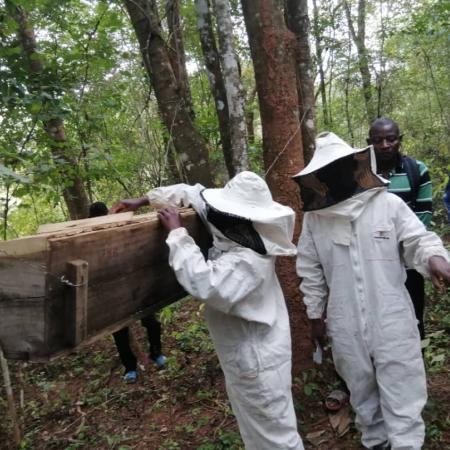
Budala VNRMC was a group of 17 women and single man. It was ambitious yet had inadequate technical knowledge and limited funding. The group had only 6 Malawi local beehives despite their eagerness to learn and discover new means of achieving great things. It did not take time for them to approach me if I could, through the project funded by European Union by then, help them technically to realise their objectives. I took them on board, trained them in assisted natural regeneration, bee keeping, business management and marketing. The project also boosted their capital by supporting them with 45 Malawi standard hives. Within the year the group made sales of over 3million Malawi kwacha. They managed to protect and manage 32 ha of degraded land where they used to hang their hives.
